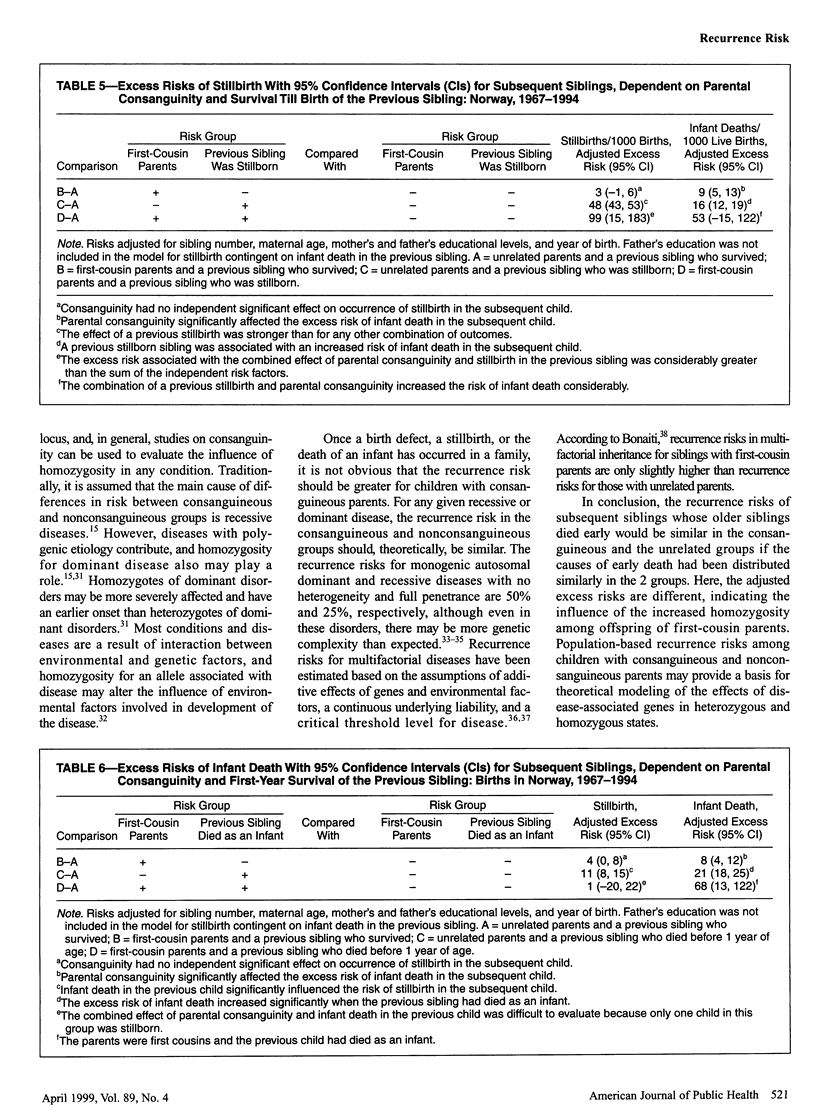Abstract
OBJECTIVES: The aim of this study was to estimate the recurrence risk for stillbirth and infant death and compare results for offspring of first-cousin parents with results for offspring of unrelated parents. METHODS: The study population consisted of all single births with a previous sibling born in Norway between 1967 and 1994. Altogether, 629,888 births were to unrelated parents, and 3466 births were to parents who were first cousins. The risk of stillbirth and infant death was estimated for subsequent siblings contingent on parental consanguinity and survival of the previous sibling. RESULTS: For unrelated parents, the risk of early death (stillbirth plus infant death) for the subsequent sibling was 17 of 1000 if the previous child survived and 67 of 1000 if the previous child died before 1 year of age. For parents who were first cousins, the risk of early death for the subsequent sibling was 29 of 1000 if the previous child survived and 116 of 1000 if the previous child died. CONCLUSIONS: The risk of recurrence of stillbirth and infant death is higher for offspring of first-cousin parents compared with offspring of unrelated parents.
Full text
PDF






Selected References
These references are in PubMed. This may not be the complete list of references from this article.
- Ahmad M., Abbas H., Haque S. Alopecia universalis as a single abnormality in an inbred Pakistani kindred. Am J Med Genet. 1993 Jun 1;46(4):369–371. doi: 10.1002/ajmg.1320460405. [DOI] [PubMed] [Google Scholar]
- Al-Awadi S. A., Moussa M. A., Naguib K. K., Farag T. I., Teebi A. S., el-Khalifa M., el-Dossary L. Consanguinity among the Kuwaiti population. Clin Genet. 1985 May;27(5):483–486. doi: 10.1111/j.1399-0004.1985.tb00236.x. [DOI] [PubMed] [Google Scholar]
- Arntzen A., Moum T., Magnus P., Bakketeig L. S. The association between maternal education and postneonatal mortality. Trends in Norway, 1968-1991. Int J Epidemiol. 1996 Jun;25(3):578–584. doi: 10.1093/ije/25.3.578. [DOI] [PubMed] [Google Scholar]
- Bittles A. H., Neel J. V. The costs of human inbreeding and their implications for variations at the DNA level. Nat Genet. 1994 Oct;8(2):117–121. doi: 10.1038/ng1094-117. [DOI] [PubMed] [Google Scholar]
- Bonaiti C. Genetic counseling of consanguineous families. Use of Smith's method to calculate recurrence risks in multifactorial inheritance in consanguineous matings. J Med Genet. 1978 Apr;15(2):109–112. doi: 10.1136/jmg.15.2.109. [DOI] [PMC free article] [PubMed] [Google Scholar]
- Bundey S., Alam H., Kaur A., Mir S., Lancashire R. Why do UK-born Pakistani babies have high perinatal and neonatal mortality rates? Paediatr Perinat Epidemiol. 1991 Jan;5(1):101–114. doi: 10.1111/j.1365-3016.1991.tb00689.x. [DOI] [PubMed] [Google Scholar]
- Clausen J. O., Hansen T., Bjørbaek C., Echwald S. M., Urhammer S. A., Rasmussen S., Andersen C. B., Hansen L., Almind K., Winther K. Insulin resistance: interactions between obesity and a common variant of insulin receptor substrate-1. Lancet. 1995 Aug 12;346(8972):397–402. doi: 10.1016/s0140-6736(95)92779-4. [DOI] [PubMed] [Google Scholar]
- Elandt-Johnson R. C. Definition of rates: some remarks on their use and misuse. Am J Epidemiol. 1975 Oct;102(4):267–271. doi: 10.1093/oxfordjournals.aje.a112160. [DOI] [PubMed] [Google Scholar]
- Fretts R. C., Usher R. H. Causes of fetal death in women of advanced maternal age. Obstet Gynecol. 1997 Jan;89(1):40–45. doi: 10.1016/s0029-7844(96)00427-9. [DOI] [PubMed] [Google Scholar]
- Grant J. C., Bittles A. H. The comparative role of consanguinity in infant and childhood mortality in Pakistan. Ann Hum Genet. 1997 Mar;61(Pt 2):143–149. doi: 10.1046/j.1469-1809.1997.6120143.x. [DOI] [PubMed] [Google Scholar]
- Hafez M., El-Tahan H., Awadalla M., El-Khayat H., Abdel-Gafar A., Ghoneim M. Consanguineous matings in the Egyptian population. J Med Genet. 1983 Feb;20(1):58–60. doi: 10.1136/jmg.20.1.58. [DOI] [PMC free article] [PubMed] [Google Scholar]
- Hamamy H. A., al-Hakkak Z. S. Consanguinity and reproductive health in Iraq. Hum Hered. 1989;39(5):271–275. doi: 10.1159/000153871. [DOI] [PubMed] [Google Scholar]
- Khlat M. Consanguineous marriages in Beirut: time trends, spatial distribution. Soc Biol. 1988 Fall-Winter;35(3-4):324–330. doi: 10.1080/19485565.1988.9988710. [DOI] [PubMed] [Google Scholar]
- Khlat M., Khoury M. Inbreeding and diseases: demographic, genetic, and epidemiologic perspectives. Epidemiol Rev. 1991;13:28–41. doi: 10.1093/oxfordjournals.epirev.a036072. [DOI] [PubMed] [Google Scholar]
- Khoury M. J., Beaty T. H., Liang K. Y. Can familial aggregation of disease be explained by familial aggregation of environmental risk factors? Am J Epidemiol. 1988 Mar;127(3):674–683. doi: 10.1093/oxfordjournals.aje.a114842. [DOI] [PubMed] [Google Scholar]
- Khoury M. J., Cohen B. H., Chase G. A., Diamond E. L. An epidemiologic approach to the evaluation of the effect of inbreeding on prereproductive mortality. Am J Epidemiol. 1987 Feb;125(2):251–262. doi: 10.1093/oxfordjournals.aje.a114524. [DOI] [PubMed] [Google Scholar]
- Khoury S. A., Massad D. Consanguineous marriage in Jordan. Am J Med Genet. 1992 Jul 15;43(5):769–775. doi: 10.1002/ajmg.1320430502. [DOI] [PubMed] [Google Scholar]
- Kiesewetter S., Macek M., Jr, Davis C., Curristin S. M., Chu C. S., Graham C., Shrimpton A. E., Cashman S. M., Tsui L. C., Mickle J. A mutation in CFTR produces different phenotypes depending on chromosomal background. Nat Genet. 1993 Nov;5(3):274–278. doi: 10.1038/ng1193-274. [DOI] [PubMed] [Google Scholar]
- Lander E. S., Schork N. J. Genetic dissection of complex traits. Science. 1994 Sep 30;265(5181):2037–2048. doi: 10.1126/science.8091226. [DOI] [PubMed] [Google Scholar]
- Li D. K., Spiers P. S. The effect of parity on the relation between maternal history of spontaneous pregnancy loss and the risk of sudden infant death syndrome in offspring. Epidemiology. 1993 Jan;4(1):48–54. doi: 10.1097/00001648-199301000-00010. [DOI] [PubMed] [Google Scholar]
- Oyen N., Skjaerven R., Irgens L. M. Population-based recurrence risk of sudden infant death syndrome compared with other infant and fetal deaths. Am J Epidemiol. 1996 Aug 1;144(3):300–305. doi: 10.1093/oxfordjournals.aje.a008925. [DOI] [PubMed] [Google Scholar]
- Rothman K. J., Greenland S., Walker A. M. Concepts of interaction. Am J Epidemiol. 1980 Oct;112(4):467–470. doi: 10.1093/oxfordjournals.aje.a113015. [DOI] [PubMed] [Google Scholar]
- Samueloff A., Xenakis E. M., Berkus M. D., Huff R. W., Langer O. Recurrent stillbirth. Significance and characteristics. J Reprod Med. 1993 Nov;38(11):883–886. [PubMed] [Google Scholar]
- Skjaerven R., Wilcox A. J., Lie R. T., Irgens L. M. Selective fertility and the distortion of perinatal mortality. Am J Epidemiol. 1988 Dec;128(6):1352–1363. doi: 10.1093/oxfordjournals.aje.a115088. [DOI] [PubMed] [Google Scholar]
- Smith C. Recurrence risks for multifactorial inheritance. Am J Hum Genet. 1971 Nov;23(6):578–588. [PMC free article] [PubMed] [Google Scholar]
- Stoltenberg C., Magnus P., Lie R. T., Daltveit A. K., Irgens L. M. Birth defects and parental consanguinity in Norway. Am J Epidemiol. 1997 Mar 1;145(5):439–448. doi: 10.1093/oxfordjournals.aje.a009126. [DOI] [PubMed] [Google Scholar]
- Stoltenberg C., Magnus P., Lie R. T., Daltveit A. K., Irgens L. M. Influence of consanguinity and maternal education on risk of stillbirth and infant death in Norway, 1967-1993. Am J Epidemiol. 1998 Sep 1;148(5):452–459. doi: 10.1093/oxfordjournals.aje.a009670. [DOI] [PubMed] [Google Scholar]
- Zlotogora J. Dominance and homozygosity. Am J Med Genet. 1997 Feb 11;68(4):412–416. doi: 10.1002/(sici)1096-8628(19970211)68:4<412::aid-ajmg8>3.0.co;2-n. [DOI] [PubMed] [Google Scholar]
- al-Gazali L. I., Dawodu A. H., Sabarinathan K., Varghese M. The profile of major congenital abnormalities in the United Arab Emirates (UAE) population. J Med Genet. 1995 Jan;32(1):7–13. doi: 10.1136/jmg.32.1.7. [DOI] [PMC free article] [PubMed] [Google Scholar]
- el-Hazmi M. A., al-Swailem A. R., Warsy A. S., al-Swailem A. M., Sulaimani R., al-Meshari A. A. Consanguinity among the Saudi Arabian population. J Med Genet. 1995 Aug;32(8):623–626. doi: 10.1136/jmg.32.8.623. [DOI] [PMC free article] [PubMed] [Google Scholar]
- el-Shafei A., Rao P. S., Sandhu A. K. Congenital malformations and consanguinity. Aust N Z J Obstet Gynaecol. 1986 Aug;26(3):168–172. doi: 10.1111/j.1479-828x.1986.tb01559.x. [DOI] [PubMed] [Google Scholar]


